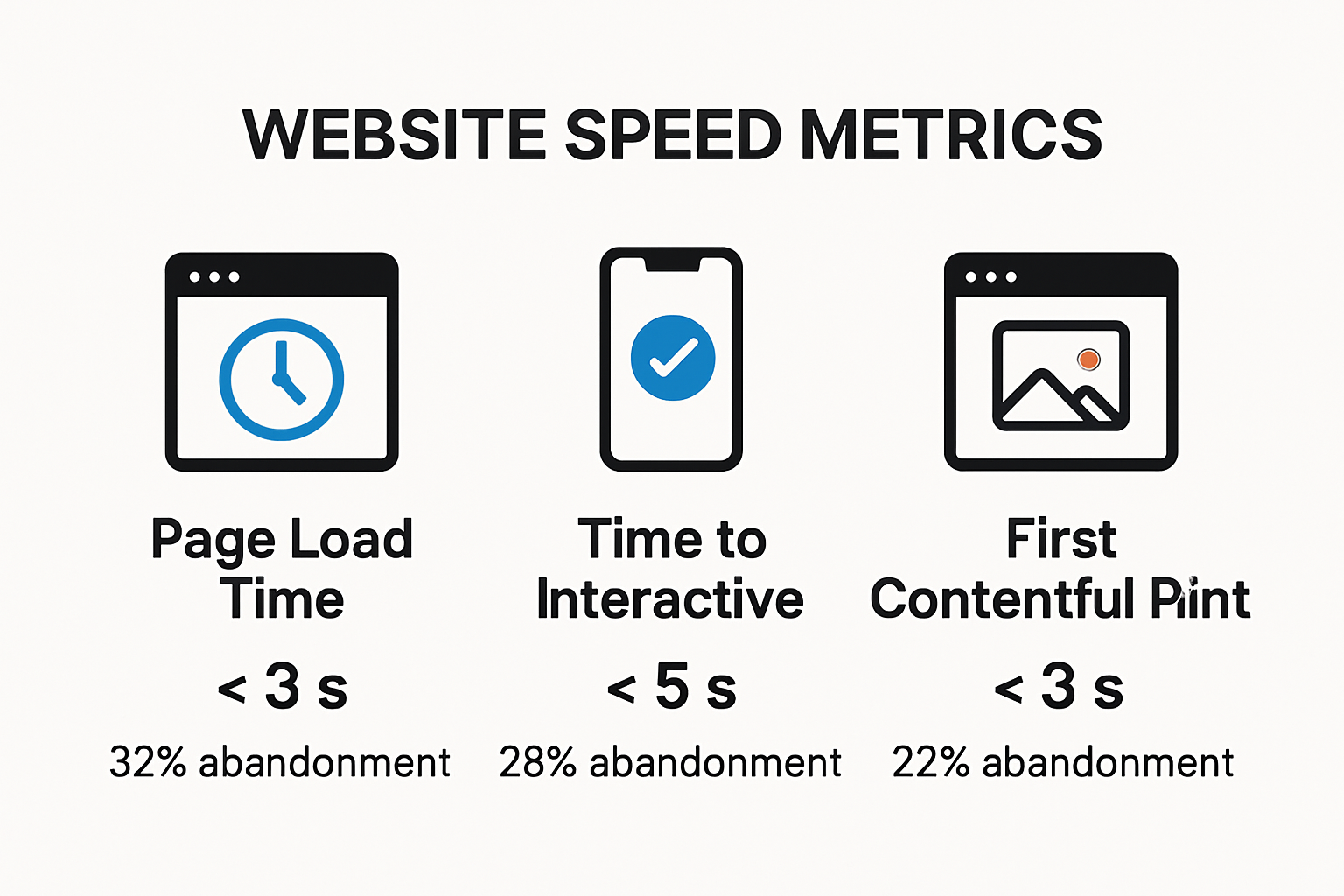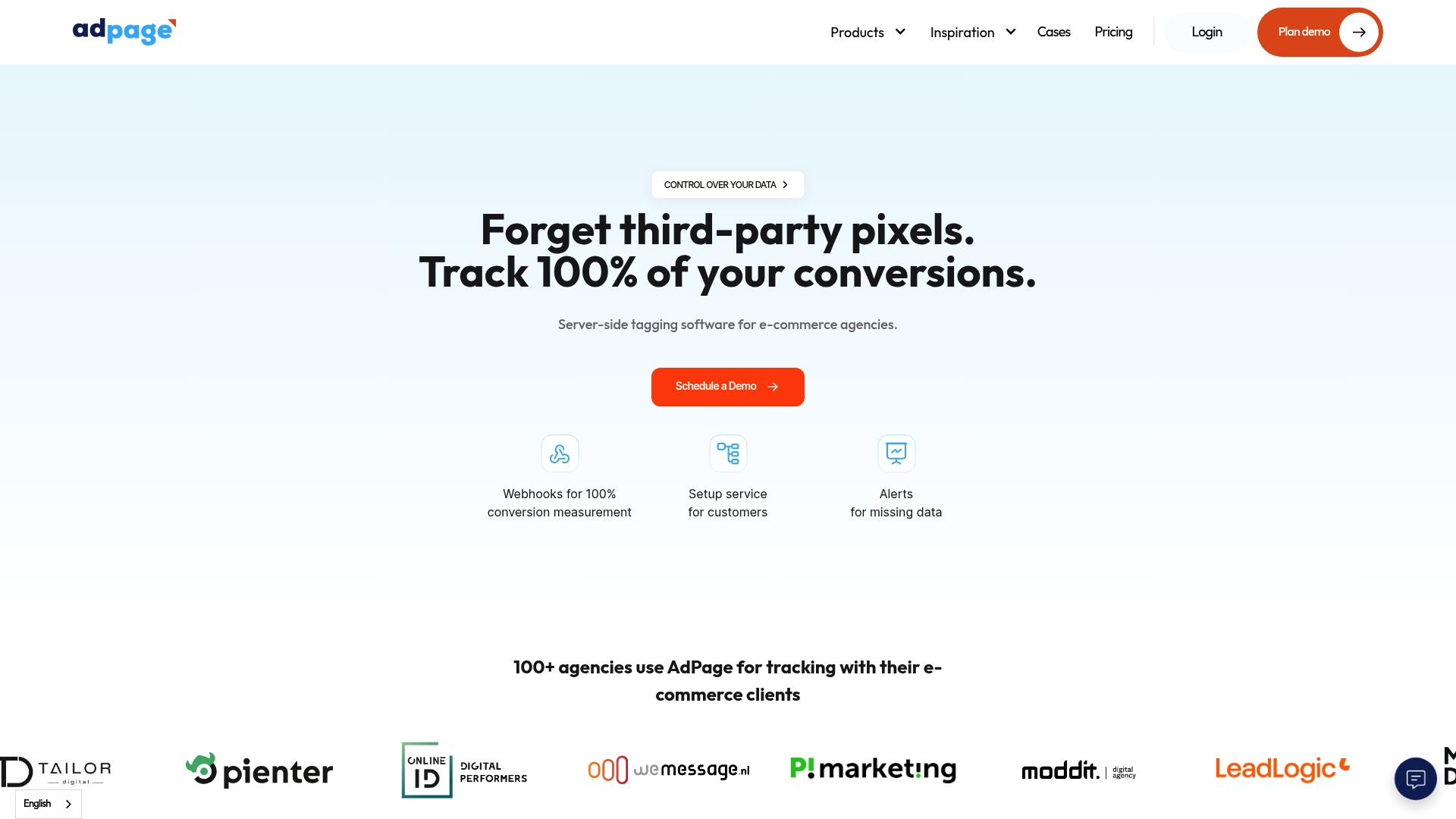Improving your website for better conversions has never been more urgent and the numbers speak for themselves. More than half of mobile users will give up on your site if it takes longer than three seconds to load. Most people assume the secret is complicated technology or flashy design. The reality is much simpler and far more surprising. The fastest route to higher sales is removing friction at every click and instantly giving visitors what they came for.
Table of Contents
- Optimizing Website Speed For E-commerce Growth
- Streamlining User Experience To Drive Conversions
- Leveraging Analytics To Measure Performance Gains
- Implementing Advanced Techniques For Lasting Results
Quick Summary
| Takeaway | Explanation |
|---|---|
| Speed impacts e-commerce success | Page load times significantly influence user abandonment rates, especially among mobile users. |
| Prioritize user experience design | Streamlined user journeys and intuitive interfaces enhance conversion rates. |
| Analytics drive continuous improvement | Leverage analytics to understand user behavior and optimize accordingly. |
| Implement advanced tracking technologies | Use heat maps and eye-tracking to refine user engagement strategies. |
| Adopt iterative design methodologies | Continuous adjustments based on user feedback ensure optimal website performance. |
Optimizing Website Speed for E-commerce Growth
Website speed represents a critical factor in e-commerce success, directly influencing user experience, search engine rankings, and conversion rates. Online businesses cannot afford to overlook performance optimization strategies that impact their bottom line.
Performance Metrics and User Expectations
Modern online consumers demand instantaneous website interactions. Research from Google reveals that 53% of mobile users abandon websites that take longer than three seconds to load. This statistic underscores the urgent need for businesses to prioritize website speed.
A comprehensive academic analysis of user interactions within e-commerce platforms highlights critical factors affecting website performance. The study emphasizes the importance of mobile optimization and browser compatibility in maintaining consistent user engagement. Key performance indicators include:
- Page Load Time: Directly correlates with user retention
- Time to Interactive: Measures responsiveness of website elements
- First Contentful Paint: Indicates visual loading speed

Here is a summary table of key website performance metrics and their impact as discussed above:
| Performance Metric | What It Measures | Impact on User Experience |
|---|---|---|
| Page Load Time | Speed at which the whole page loads | Affects retention; slower pages increase abandonment |
| Time to Interactive | Time until page is fully responsive | Delays reduce perceived quality and usability |
| First Contentful Paint | Time until first element appears visually | Faster paint improves perceived speed |
| Mobile Optimization | Adaptability to mobile devices | Crucial for majority of traffic and engagement |
| Browser Compatibility | Consistency across different browsers | Ensures all users have smooth experience |
Technical Optimization Strategies
Implementing technical optimization requires a multifaceted approach. Website owners must focus on reducing server response times, minimizing resource-heavy scripts, and implementing efficient caching mechanisms. Compression techniques for images and scripts can significantly reduce load times without compromising visual quality.
Complex Web site architectures often introduce performance bottlenecks. Developers should:
- Utilize content delivery networks (CDNs).
- Implement lazy loading for images and multimedia
- Minify CSS, JavaScript, and HTML resources
- Prioritize critical rendering paths
Advanced performance optimization involves balancing user experience with visual intensity. Research methodologies suggest creating adaptive design frameworks that dynamically adjust website elements based on user device capabilities and network conditions.
Monitoring and continuous improvement remain essential. Regular performance audits using tools like Google PageSpeed Insights can help identify and address potential bottlenecks. E-commerce businesses should establish baseline performance metrics and develop iterative optimization strategies.
Ultimately, website speed is not just a technical consideration but a fundamental aspect of digital customer experience. By investing in performance optimization, businesses can create faster, more responsive online environments that convert visitors into loyal customers.
Streamlining User Experience to Drive Conversions
User experience (UX) represents the cornerstone of successful digital conversion strategies. Businesses that prioritize seamless, intuitive interactions can significantly enhance their ability to transform website visitors into committed customers.
Understanding User Journey Mapping
Research from the Delaware Government Information Center highlights the critical importance of mapping user journeys to identify potential friction points. By meticulously examining each interaction stage, businesses can strategically simplify transactional processes and minimize user frustration.
Effective user journey mapping involves:
- Comprehensive User Persona Development: Creating detailed representations of target audience segments
- Interaction Flow Analysis: Tracking user movements through website interfaces
- Pain Point Identification: Recognising potential obstacles in conversion pathways
Design Principles for Conversion Optimization
Case studies from the Georgia Department of Revenue demonstrate how strategic design modifications can dramatically improve user engagement. By implementing user-centered design principles, organizations can create more intuitive and accessible digital experiences.
Key design strategies include:
- Minimizing cognitive load through clean, uncluttered interfaces
- Implementing clear, actionable call-to-action buttons
- Ensuring consistent navigation across all website sections
- Developing responsive designs that adapt seamlessly to different devices
Measurement and Continuous Improvement

Conversion optimization is not a one-time effort but an ongoing process of refinement. Businesses must continuously collect and analyze user interaction data to understand behavior patterns and implement targeted improvements.
Recommended measurement techniques involve:
- Utilizing advanced analytics platforms
- Conducting regular user testing sessions
- Implementing heat mapping technologies
- Gathering direct user feedback through surveys and interaction tracking
Successful UX design transcends aesthetic considerations. It represents a strategic approach to understanding and anticipating user needs, creating digital environments that naturally guide visitors toward desired conversion actions. By investing in comprehensive user experience research and implementation, businesses can develop more engaging, effective online platforms that consistently deliver exceptional customer interactions.
Leveraging Analytics to Measure Performance Gains
Analytics serve as the cornerstone of understanding digital performance, providing businesses with critical insights into user behavior, conversion pathways, and website effectiveness. By implementing sophisticated analytical strategies, organizations can transform raw data into actionable intelligence that drives strategic decision making.
Advanced Analytical Frameworks
Research from Science Direct highlights the complexity of selecting appropriate metrics within organizational contexts. Effective analytics go beyond simple traffic measurements, requiring nuanced interpretation of multidimensional data points that reveal deeper user interactions.
Key analytical dimensions include:
- Conversion Rate Tracking: Measuring precise user action completion
- User Behaviour Mapping: Understanding navigation patterns and engagement
- Segmentation Analysis: Identifying distinct user group characteristics
- Performance Benchmarking: Comparing metrics against industry standards
Below is a comparison table outlining the major analytical dimensions and their objectives, as covered in this section:
| Analytical Dimension | Objective | Key Benefit |
|---|---|---|
| Conversion Rate Tracking | Measure action completion (e.g., sales, signups) | Quantifies effectiveness of website |
| User Behaviour Mapping | Track navigation paths and engagements | Reveals friction points and opportunities |
| Segmentation Analysis | Differentiate user groups and characteristics | Enables personalized optimization |
| Performance Benchmarking | Compare with industry standards | Identifies competitive strengths/weaknesses |
Performance Metrics and Interpretation
Clinical research publications emphasize the importance of commercially available analytical tools in deciphering complex user engagement patterns. Modern analytics platforms offer granular insights that enable businesses to:
- Identify potential conversion barriers
- Understand user demographic interactions
- Predict potential drop-off points in user journeys
- Develop targeted optimization strategies
Continuous Performance Optimization
Analytics represent an ongoing process of measurement, interpretation, and strategic adjustment. Successful organizations view data not as a static report but as a dynamic tool for continuous improvement. This approach requires:
- Regular performance reviews
- Hypothesis testing through controlled experiments
- Iterative website design modifications
- Adaptive strategy development based on empirical evidence
The most effective analytical approaches integrate quantitative metrics with qualitative user experience insights. By combining numerical data with user feedback and behavioral observations, businesses can develop a comprehensive understanding of their digital performance landscape.
Ultimately, analytics transform raw data into strategic intelligence. They provide a clear, objective lens through which businesses can understand user interactions, optimize digital experiences, and drive meaningful conversion improvements. Organizations that master analytical interpretation will consistently outperform competitors by making data-driven decisions that directly enhance user engagement and business outcomes.
Implementing Advanced Techniques for Lasting Results
Advanced conversion optimization requires a sophisticated approach that goes beyond traditional strategies. By leveraging cutting-edge technologies and data-driven methodologies, businesses can create more intelligent, responsive digital experiences that consistently drive performance improvements.
Precision User Experience Design
Research by Jankowski et al. reveals a critical insight into website design optimization: there exists a precise balance between visual intensity and user conversion potential. This nuanced approach suggests that incremental adjustments can significantly impact user engagement and conversion rates.
Key strategies for precision design include:
- Dynamic Visual Adaptation: Tailoring interface elements to user preferences
- Contextual Element Placement: Strategically positioning critical conversion elements
- Responsive Design Calibration: Ensuring optimal experience across different devices
Advanced Interaction Tracking
Eye-tracking research by Veeravalli demonstrates the power of sophisticated user behavior analysis. By understanding precise user gaze patterns and interaction points, businesses can create more intuitive and engaging website experiences.
Critical tracking techniques involve:
- Implementing advanced heat mapping technologies
- Analyzing micro-interactions and user navigation patterns
- Developing predictive user behavior models
- Creating personalized user experience pathways
Evolutionary Optimization Techniques
Miikkulainen et al.'s research introduces groundbreaking approaches to website optimization through evolutionary computation. This approach allows for simultaneous testing of multiple design variations, identifying complex interactions that traditional methods might miss.
Evolutionary optimization strategies include:
- Parallel design candidate evaluation
- Automated A/B testing frameworks
- Machine learning-driven design refinement
- Real-time performance adaptation
The most successful digital strategies view optimization as a continuous, adaptive process. By embracing advanced techniques that combine sophisticated tracking, intelligent design, and data-driven insights, businesses can create digital experiences that not only meet but anticipate user needs.
This approach requires a holistic perspective that integrates technological innovation with deep understanding of user psychology. Organizations that master these advanced techniques will develop more responsive, engaging digital platforms that consistently outperform traditional design methodologies.
Ultimately, the future of digital conversion lies in intelligent, adaptive systems that can dynamically respond to user behavior. By investing in advanced optimization techniques, businesses can create more meaningful, effective digital interactions that drive sustainable growth and user satisfaction.
Frequently Asked Questions
What is the impact of website speed on conversions?
Website speed directly influences user abandonment rates. More than half of mobile users will leave a site if it takes longer than three seconds to load, making speed crucial for conversions.
How can I optimize my website for better user experience?
Streamlining the user experience involves understanding user journeys, simplifying navigation, reducing cognitive load, and ensuring responsive design across devices to enhance engagement and conversion rates.
What analytics should I use to measure website performance?
Utilize advanced analytics tools to track key performance metrics such as conversion rates, user behavior, and engagement patterns. This data helps identify areas for improvement and informs optimization strategies.
What advanced techniques can improve website performance?
Implementing advanced techniques such as precision user experience design, advanced interaction tracking, and evolutionary optimization can significantly enhance your website's responsiveness and conversion potential.
Take Control of Your Conversion Tracking for Real Results
You have read how even small performance gaps can lead to missed sales and lost insights. The article made it clear that site speed, frictionless journeys and trustworthy data drive higher conversion rates. But even with the best UX and site speed, traditional analytics often fail to track every user interaction, especially with growing privacy restrictions and browser changes. This can quietly erode your results before you notice the impact. If you are worried about data loss, unreliable reports or wasted ad spend, AdPage offers a powerful and simple way forward.

AdPage delivers 100% accurate conversion measurement through server-side tagging that keeps your data intact, even as browsers and privacy laws evolve. Optimize your campaigns with live reporting, GDPR-compliant consent tools and easy integration for Shopify, WooCommerce or Magento. Marketing agencies and e-commerce teams trust AdPage to ensure every conversion is counted and every opportunity is visible. If you want to secure your revenue and stay ahead of the competition, take the next step now. Discover what complete tracking can do for your bottom line with AdPage. Visit the AdPage conversion tracking platform today and start closing the gap between insight and action.



.png)
